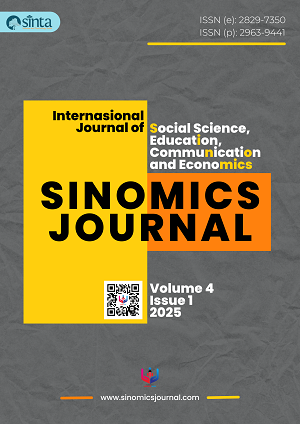Enhancing Agricultural Development: Innovations and Strategies for Sustainable Growth
DOI:
https://doi.org/10.54443/sj.v4i1.462Keywords:
agricultural development, sustainable growth, innovationAbstract
Agricultural development is pivotal for economic growth, food security, and poverty alleviation, particularly in developing countries. This paper explores the factors driving agricultural development, innovative practices, and strategic frameworks essential for sustainable growth. The research highlights the interconnections between technology adoption, policy frameworks, and market access, emphasizing the need for an inclusive approach that addresses the needs of smallholder farmers who constitute a significant portion of the agricultural workforce. Through a comprehensive review of current literature, case studies, and empirical data analysis, the study identifies key challenges facing the agricultural sector, such as climate change, land degradation, and access to resources. Innovations in agricultural practices, including precision farming, biotechnology, and sustainable land management, are discussed as vital components for enhancing productivity and resilience. Additionally, the role of policy interventions in promoting agricultural research and development, facilitating access to markets, and ensuring food security is critically assessed. The findings indicate that fostering collaboration among stakeholders—governments, private sectors, and local communities—is crucial for achieving sustainable agricultural development. Ultimately, this research aims to provide actionable insights and policy recommendations that promote agricultural innovation and improve the livelihoods of farmers, thereby contributing to enhanced food security and economic prosperity.
Downloads
References
Aker, J. C., & Fafchamps, M. (2016). How does information technology improve agricultural production? The World Bank Research Observer, 31(2), 217–241.
Altieri, M. A. (1999). The ecological impact of agroecology. Agriculture Ecosystems & Environment, 74(1), 1–3.
Antle, J. M., & Valdivia, R. O. (2006). Climate change and agriculture in the developing world: A PCA approach to assess policy vulnerabilities. Journal of Economic Integration, 21(4), 555–586.
Bhaduri, A., & Singh, S. (2016). Analyzing the impact of climate change on food security in India. Global Environmental Change, 39, 517–530.
Caswell, M. (2001). Environmental and economic effects of sustainable agriculture technology. Environmental and Resource Economics, 18(2), 185–200.
Chambers, R. (1994). Participatory rural appraisal (PRA): Analysis of experiences. World Development, 22(9), 1254–1258.
Diagana, B. (2015). Climate-smart agriculture in Africa: A case for transformational change. African Journal of Agricultural and Resource Economics, 10(1), 1–22.
Duflo, E., Kremer, M., & Robinson, J. (2011). Planning without forecasts: A behavioral and implementation perspective on development policy. Working Paper.
ECA. (2018). Economic report on Africa 2018: Making the most of Africa's commodities: Industrializing for growth, job creation and wealth. United Nations Economic Commission for Africa.
FAO. (2015). The state of food insecurity in the world 2015. Food and Agriculture Organization of the United Nations.
Fang, Y., Huang, J., & Yang, J. (2018). The impact of genetically modified technology on yield, environmental quality, and farmers' income: Evidence from smallholder farmers in China. Agricultural Economics, 49(2), 251–264.
Godfray, H. C. J., & others. (2010). Food security: The challenge of feeding 9 billion people. Science, 327(5967), 812–818.
Gollin, D., & Rogerson, R. J. (2010). Agriculture, roads, and economic development in Uganda. Journal of Development Economics, 93(1), 136–148.
IFAD. (2014). The state of food and agriculture 2014: Innovation in family farming. International Fund for Agricultural Development.
IPCC. (2019). Climate change and land: An IPCC special report on climate change, desertification, land degradation, sustainable land management, food security, and greenhouse gas fluxes in terrestrial ecosystems.
Koutouki, K., & Dalgic, A. (2020). Disaster risk reduction in agriculture: The role of agricultural insurance in climate change adaptation. Agricultural Science & Technology, 26(3), 115–125.
Lobell, D. B., Schlenker, W., & Costa-Roberts, J. (2011). Climate trends and global crop production since 1980. Science, 333(6042), 616–620.
McIntyre, B. D., Herren, H. R., Wakhungu, J., & Watson, R. T. (2009). Agriculture at a crossroads: Global report. IAASTD.
Pannell, D. J., et al. (2014). Understanding and supporting the adoption of environmental innovations: A research agenda. Environmental Management, 20(3), 283–293.
Pingali, P. (2012). Green revolution: Impacts, limits, and the path ahead. Proceedings of the National Academy of Sciences of the United States of America, 109(31), 12302–12308.
Pretty, J. N. (2008). Agricultural sustainability: Concepts, principles, and evidence. Philosophical Transactions of the Royal Society B: Biological Sciences, 363(1491), 447–465.
Shiferaw, B., et al. (2014). Managing vulnerability to climate change: The role of technology, market and policies within smallholder agriculture. International Journal of Climate Change Strategies and Management, 6(3), 287–312.
Smith, P., et al. (2014). Agriculture, forestry and other land use (AFOLU). In Climate change 2014: Mitigation of climate change; contribution of Working Group III to the Fifth Assessment Report of the Intergovernmental Panel on Climate Change (pp. 811–922). Cambridge University Press.
Thornton, P. K., & Herrero, M. (2014). Climate change and the livestock sector – A global assessment of the impacts of climate change on livestock and the livestock sector. Food and Agriculture Organization of the United Nations.
UNDP. (2020). Human development report 2020: The next frontier: Human development and the Anthropocene. United Nations Development Programme.
Uphoff, N. (2002). Agroecological innovations: Increasing food production with participatory development. Earthscan.
Wiggins, S., & Mustafa, M. (2017). The future of smallholder farming. Overseas Development Institute.
World Bank. (2016). Agriculture for development: World development report. World Bank Publications.
World Bank. (2021). World development indicators. World Bank.
Downloads
Published
How to Cite
License
Copyright (c) 2025 Abdul Rochman

This work is licensed under a Creative Commons Attribution 4.0 International License.






 Results From Scopus: 80 Citedness
Results From Scopus: 80 Citedness















